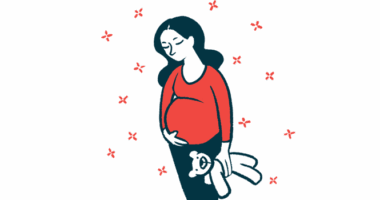Takhzyro Use Resulted in Prolonged Dosing Intervals, Fewer Treatments
Analgesic, antidepressant use also declined after 1 year of treatment

Half the patients with hereditary angioedema (HAE) treated with Takhzyro (lanadelumab) for at least a year prolonged their dosing interval and used significantly less on-demand treatments, a real-world study found.
Study findings were detailed in a clinical letter titled, “Real World treatment patterns of hereditary angioedema with lanadelumab in Germany: A prescription data analysis,” published in the Journal of the German Society of Dermatology.
HAE results from large amounts of bradykinin, an inflammatory substance that causes blood vessels to widen and fluid to leak into nearby tissues, leading to sudden swelling attacks in the deeper layers of the skin. The amount of bradykinin released is strongly controlled by another protein called kallikrein.
Takhzyro is an antibody-based treatment that targets and inhibits kallikrein in the bloodstream. By blocking kallikrein’s activity, the treatment can lower bradykinin levels. Takhzyro is widely approved as a preventive, or prophylactic, treatment for acute swelling attacks in HAE patients, 12 and older.
However, real-world data on the use of Takhzyro in HAE patients is scarce, leading researchers to analyze anonymized prescription data from Takhzyro, including data on pre-therapy, dose intervals, and use of other HAE medications. Data was obtained from a population of German HAE patients from January 2018 to June 2020.
Based on the total number of prescribed vials, 144 patients with at least one Takhzyro prescription (starting January 2019) were found. Of these, 106 were given Takhzyro for at least four months, 87 for at least six months, and 44 for at least a year.
Among the 106 patients with at least four months of treatment, 33 (31%) were treated with Takhzyro at extended dose intervals, meaning one vial for at least 17 days (about two weeks). In patients treated for at least a year, this rate increased to 48%. Dose intervals were calculated using the number of prescribed vials from one prescription divided by the number of days until the next prescription.
These findings may suggest that “lanadelumab, when used every two weeks, results in freedom of attacks in many patients, as interval extension is only recommended in attack-free patients,” the researchers wrote.
Nine patients were not receiving any HAE treatment before starting Takhzyro. According to researchers, these patients “may have been enrolled in a clinical trial,” or “may have been newly diagnosed with HAE and … truly treatment-naïve.”
On-demand treatment declines sharply
The study also found that prophylactic treatment was prescribed to 13 patients, while 31 had been prescribed with both prophylactic and on-demand treatment.
The study also compared the number of prescribed medications used for HAE treatment, such as Cinryze, Berinert, and Firazyr (icatibant) before and after treatment with Takhzyro.
Results showed that during the first year of Takhzyro treatment, other HAE medications were prescribed significantly less — a reduction of more than 90% — compared to the 12 months before starting Takhzyro. Specifically, the number of prescribed vials for on-demand treatment with Cinryze decreased by 94%, with Berinert by 93%, and with Firazyr by 67%.
These results “indirectly show real world effectiveness,” the research team wrote.
Since severe attacks may occur, such as those that may cause asphyxiation, “patients with HAE who receive prophylactic treatment, including lanadelumab, must be prescribed on-demand medication and be reminded to carry it,” they wrote. “With more effective prophylactic treatments, physicians must remember to check the expiration date of their patients’ on-demand treatment and to regularly train patients in their use.”
Treatment with concomitant medications was also analyzed, including analgesics and antidepressants.
Of the 44 patients treated with Takhzyro for at least a year, 10 (23%) had at least one prescription for analgesics and six (14%) had at least one prescription for antidepressants before starting Takhzyro. In the 12 months after starting Takhzyro, the number of patients prescribed analgesics decreased to eight, while less than five were given prescriptions for antidepressants.
Consistent with previous clinical trials that showcased Takhzyro’s effectiveness, including the Phase 3 HELP trial (NCT02586805) and its open-label extension study (NCT02741596), these results “indirectly suggest that lanadelumab may help patients with HAE achieve higher rates and levels of controlled disease than previously observed with on-demand treatment only,” the researchers wrote.







